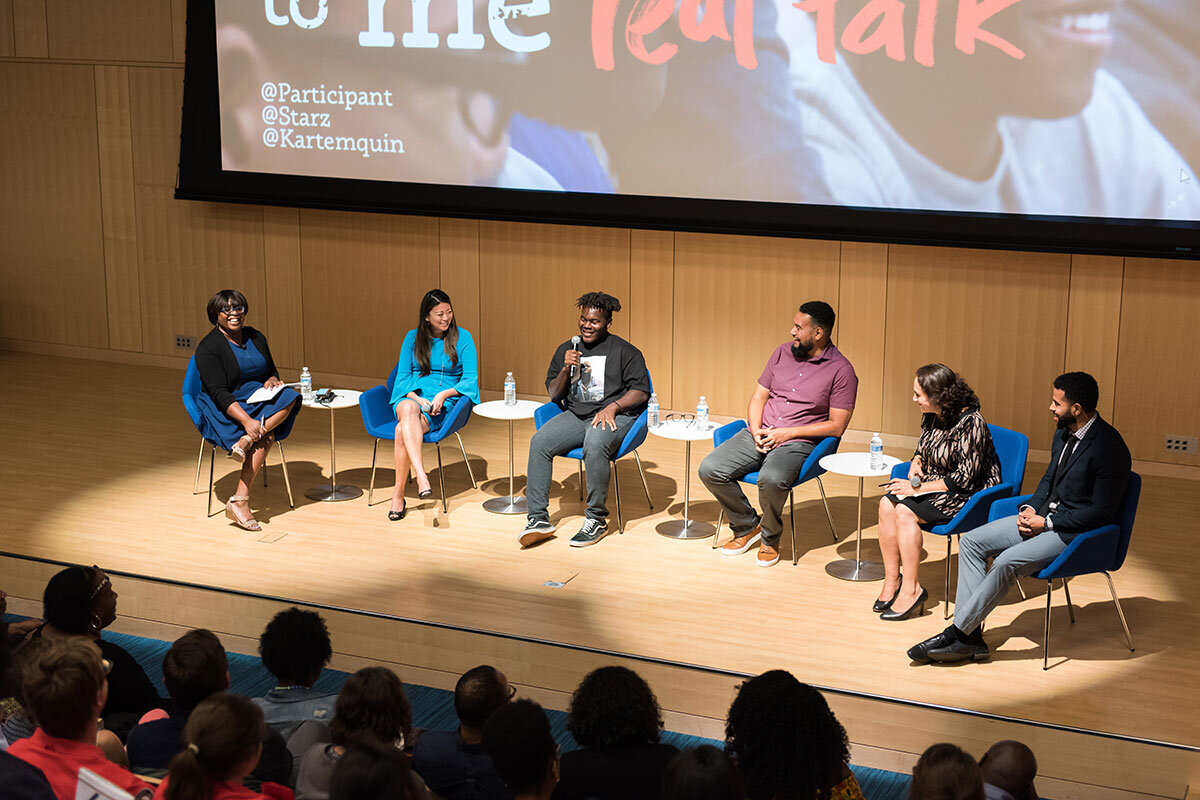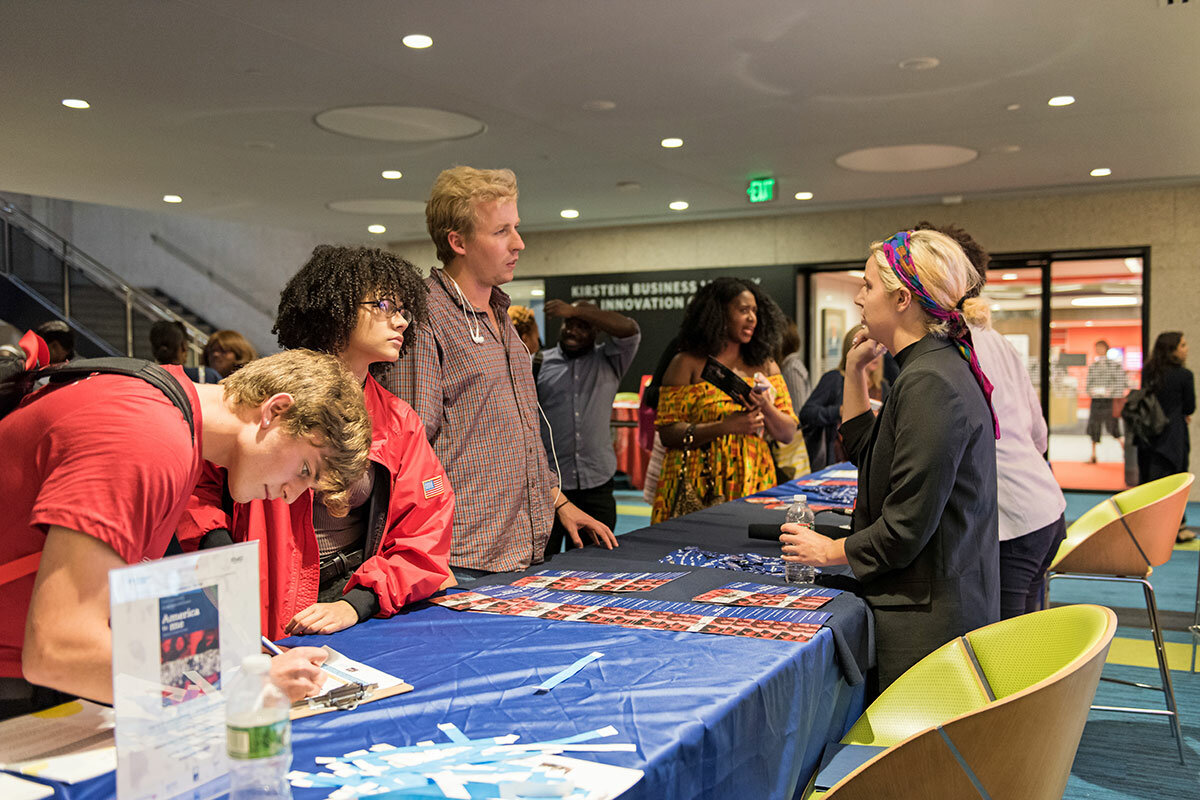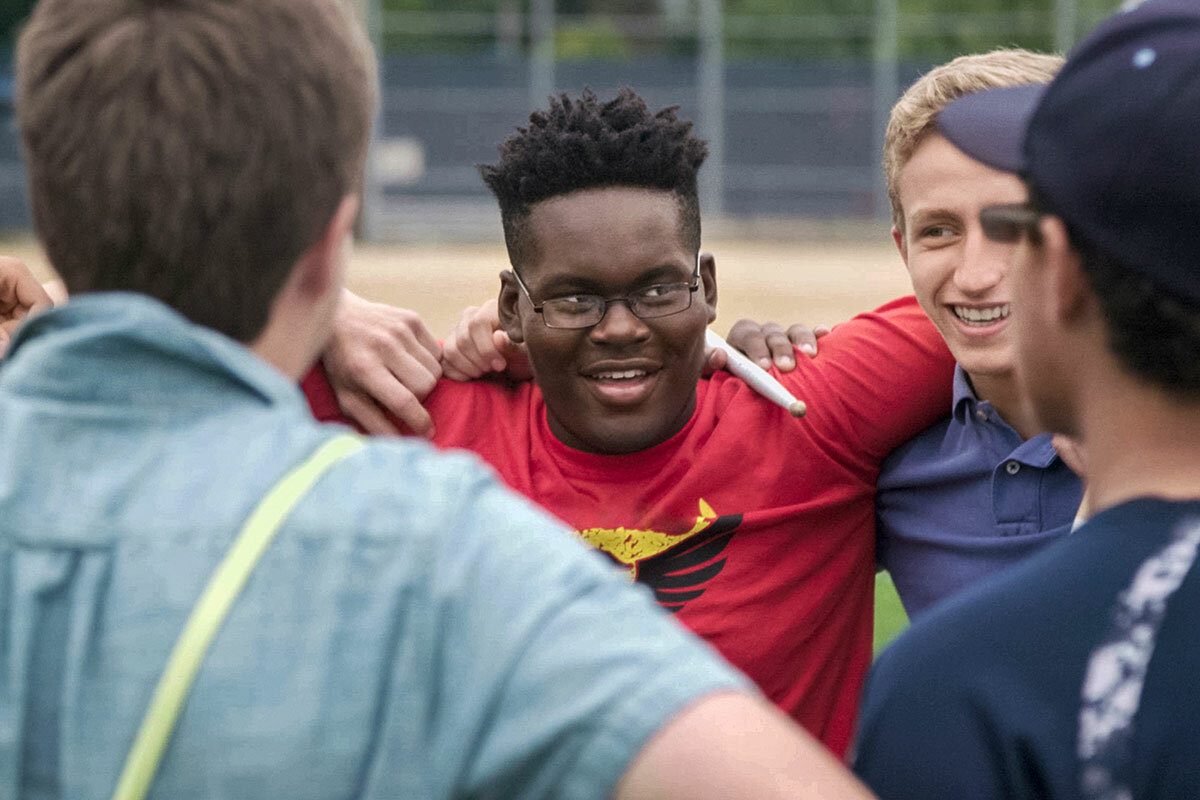Integrated but unequal: a world laid bare by high-schoolers, documented on film
Loading...
| Boston
Karen Bauerle has two children in school in Belmont, Mass., a wealthy suburb of Boston whose education system “could really benefit from some facilitation regarding issues of race,” she says. So when she heard about a chance to set up a “watch group” to discuss a new 10-part documentary that delves into race and educational equity, she eagerly signed on.
“People like myself, identifying as Caucasian,... need to be honest [about] the continuation of segregation in society, racism.... I want to be part of this change,” she says, explaining what brought her to the Boston Public Library Sept. 13 for a screening of an episode of “America to Me” – a kickoff event before the small watch groups start discussing the documentary and how it connects to their communities.
For the STARZ series, filmmaker Steve James and his crew followed teachers, students, and families at Oak Park and River Forest High School (OPRF) in the diverse Chicago suburb of Oak Park, Ill. It’s a place that has avoided the racial isolation that’s common in many schools and neighborhoods across the US. But the series begins to unpack the complexities that arise, and the damage that can be done, when layers of racial bias and structural inequity linger, even in desegregated liberal bastions.
Why We Wrote This
Diverse, liberal communities can still harbor racism and inequity. Can the honest stories of young people compel adults to pay attention? A 10-part TV series is urging more conversations.
Participant Media and local partners are promoting “America to Me” in a 10-city tour – urging communities to use that offer an episode-by-episode structure for conversations people are hungry to have, but perhaps lack a good recipe to follow. So far, nearly 8,000 people have signed up to participate in watch groups.
Many of the protagonists in the series are students of color, and their interactions with teachers run the gamut from genuine friendship to awkward coexistence. The stories of the chatty cheerleader, the biracial spoken-word enthusiast, the overscheduled wrestler, and so many more – full of universal angst, humor, and drama – will resonate widely.
“By walking in the shoes of these kids, you see the world through their eyes…. You can make visible … and make personal what otherwise feels like something happening to other people,” says Holly Gordon, chief impact officer of Participant Media, which also produced “Waiting for ‘Superman.’ ”
A community screening
In Boston, the 300-plus audience erupted with murmurs of dismay as a scene from episode 4 unfolded, with a white science teacher so eager to show his black students that he relates to them that he crossed the line into stereotyping and denigrating. He seemed utterly unaware how upsetting his words were, but for the audience watching the students’ faces, it was obvious.
“He just came at it all wrong,” said Lauren Reinhold after the event. She was one of several dozen young people recognizable at the screening by their red jackets with the logo of City Year, a youth service corps that supports urban schools. Ms. Reinhold is white and grew up in New Hampshire, and her training is preparing her for working with students of different racial and socioeconomic backgrounds.
“A big part of it is humility,… not going into the classrooms with the idea that we’re going to ‘save’ the kids. We wear red jackets, not red capes,” she says.
Ms. Bauerle also cringed at the scene, but later confessed: “I’m afraid that I’m like that sometimes – that I can think I understand things about race when in fact, I’m just in my own echo chamber.”
She was eager to watch more episodes, and wondered if the teacher would redeem himself as the series unfolds.
“America to Me” is “an honest reflection of where we’re at right now, especially education and kids of color in the system,” said Jackie Robinson (no, he said with a smile at the inevitable question, it’s not a joke). An African-American from nearby Arlington, Mass., Mr. Robinson is friends with Bauerle, and they both attend a group that addresses social justice.
“A lot of materials we use to have these discussions are kind of dated, and this is something that’s actually happening now and it’s affecting our kids,” Robinson added.
Bauerle hopes to persuade some members of the Belmont school committee to watch the series. But her friend, Jill Clark, said there is some resistance to these conversations in well-resourced communities, because people often “pretend that our students of color are just going to act like our white students [and that] we’re at a level playing field, but that’s not true.”
The documentary doesn’t demonize anyone, but it brings up what can sometimes happen when schools don’t give staff adequate support.
Educators need “helpful professional development,” said Jessica Tang, president of the Boston Teachers Union, during the panel discussion. “You can’t just say, ‘Talk about race in class.’ That can do more damage than good” if not done well.
Kendale McCoy, a senior at OPRF when filming took place in 2015-16, came to Boston for the screening. While he experienced plenty of bias, he also credits his white English teacher for being fair and giving him a “second chance” when he was going through some struggles.
Since the film came out, “people are starting to maybe open their minds a little bit” to recognize racial bias at the school, he said.
Now a junior at Cornell College in Iowa, Mr. McCoy plans to become a teacher. “I knew how I wanted to be treated in high school, and I didn’t really get that all the time,” he said. “A big thing is holding all students to the same standard and treating them with respect.”
Training before talking
The Saturday after the screening, Bauerle and about 60 other watch leaders showed up at the Boston Foundation for a four-hour training session, to prepare for leading discussions in the coming weeks. Darnisa Amante, co-founder and executive director of the Disruptive Equity Education Project (DEEP), promptly dove into the history of how education has sorted people in a way that reinforces inequities.
As they turned to understanding their biases and how these can affect other people, Dr. Amante spoke about her experience as a black woman who has a doctorate and wears her that reach her waist – and how often people marginalize her by playing with her hair or commenting on how “articulate” she is.
Participants in small groups reflected on their biases. Carlos Sanchez, a Boston City Year corps member, said he found it “amazing to have a moment to sit with and to be able to start thinking about how to address and understand any implicit and internal biases that I might have.”
The training was designed to challenge people, not to make them feel guilty.
“It’s not about blame,” Amante says in an interview. But “we do have to name that there is a whole system that creates inequity ... [and name] what part of that system we’ve embodied unknowingly -- the assumptions we make, which students we think will be successful.”
For Boston, this new round of conversations, she says, “allows us to be hopeful.”
“America to Me” Real Talk screening events will be happening next in Los Angeles (Sept. 23); Washington (Sept. 27); Dallas (Oct. 3); Charlotte, N.C. (Oct. 10); Oakland, Calif., (Oct. 18); and Chicago (Oct. 25)
This is story is part of an occasional series, Learning Together, on efforts to address segregation.��






